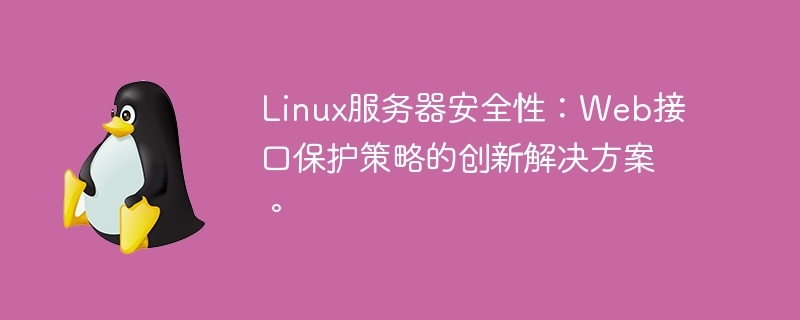

Linux servers play an important role in today's Internet era and are widely used for hosting and deployment of web applications. However, due to its widespread use, Linux servers have also become a target for attackers. In order to protect the security of the server, Web interface protection strategy has become an essential task.
This article will introduce an innovative solution to improve the security of Linux servers and protection strategies for web interfaces, and deepen understanding through code examples.
First, we need to use a firewall to restrict access to the server. Below is an example of a simple iptables rule that allows access to a server's HTTP and SSH ports from specific IP addresses while denying access from other IPs.
iptables -A INPUT -p tcp -s 192.168.1.100 --dport 80 -j ACCEPT iptables -A INPUT -p tcp -s 192.168.1.100 --dport 22 -j ACCEPT iptables -A INPUT -p tcp --dport 80 -j DROP iptables -A INPUT -p tcp --dport 22 -j DROP
In the above code, the first two rules allow the host with the IP address 192.168.1.100 to access the server's port 80 (HTTP) and port 22 (SSH), while the last two rules deny access to other IP addresses. .
Secondly, we can use Fail2ban to prevent malicious login attempts. Fail2ban is a Python-based application that monitors log files on a server and automatically adds the attacker's IP address to the firewall's blacklist when multiple failed login attempts are detected. Below is a simple Fail2ban configuration example.
[DEFAULT] bantime = 86400 findtime = 600 maxretry = 3 [sshd] enabled = true port = ssh filter = sshd logpath = /var/log/auth.log [http-get-dos] enabled = true port = http,https filter = http-get-dos logpath = /var/log/apache2/access.log
In the above configuration file, the bantime parameter defines the time (in seconds) for the attacker to be added to the blacklist, the findtime parameter defines the time period for the number of failed login attempts that triggers the addition of the blacklist, and the maxretry parameter defines the The maximum number of attempts allowed for the same IP.
Finally, we can use ModSecurity to enhance the security of our web applications. ModSecurity is an open source web application firewall that can detect and prevent different types of attacks, such as cross-site scripting attacks (XSS), SQL injection attacks, etc. The following is a simple ModSecurity configuration example.
SecRuleEngine On SecAuditEngine On SecResponseBodyAccess On SecRule REMOTE_ADDR "^127.0.0.1$" phase:1,nolog,allow SecRule REQUEST_HEADERS:User-Agent "bot" "phase:1,deny,id:10001" Include /etc/modsecurity/crs/*.conf
In the above configuration file, the SecRuleEngine and SecAuditEngine parameters are used to enable ModSecurity and audit logging functions, and the SecResponseBodyAccess parameter is used to allow access to the response content.
SecRule and SecResponseBodyAccess are used to allow requests from local IP addresses and deny requests that contain the "bot" string in the User-Agent.
Through the innovative solutions introduced above, we can improve the security of Linux servers and the protection strategy of Web interfaces. However, server security is a dynamic process that requires constant updates and maintenance. Developers and system administrators should pay close attention to server security vulnerabilities and the latest security threats, and take appropriate measures to protect server security.
The above is the detailed content of Linux Server Security: Innovative Solutions for Web Interface Protection Strategies.. For more information, please follow other related articles on the PHP Chinese website!




